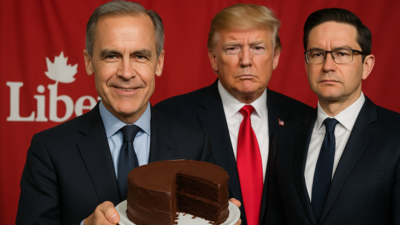Mark Carney Strong, but it is only short: How the liberals fell after an amazing return in Canada’s polls

[ad_1]
Before the opening of opinion polls on April 28, Mark Carney He had already organized a great return. In mid -January, the conservatives held 27 points on the liberals. But by the election night, the Carney party rose to 168 seats, only four shy of the 172 needed for the majority. Some expectations, including Ecus on April 27, have expected even liberals who cross this decisive threshold.
In this event, they fell four short seats. Softening positions late in President Trump’s speech to combat Canada narrowed the early advantage of Carne, and allowed the governor of Pierre Puyviri to fill the gap to only two degrees in popular vote.
Jolly Simps of Jelf University, while talking to her Timesofindia.comIt argues that the external pressure and the voting system in Canada explain why the majority does not happen.
The majority on the horizon
By the last week of the campaigns, national followers regularly showed liberals who resigned about 44 percent to the 39 percent conservatives.
Jolly Simons believes that Carney credit papers are fueled by this increase: “It was largely a large part of that support about the new leader (Carney), who seemed more qualified, as a former governor of the Bank of Canada, more than job policy (conservative leader,” Berler Boyle) to take over in the field of Narawah in Canada.
Trump’s tone turned into the competition
However, just as the liberals seemed prepared for a small majority, the external threat that started the Carne’s call below. Simons notes that after a special phone call between Carney and Trump, the American president has largely brought down his general threats against Canada.
“Poilievre returned to his messages about being difficult for the crime, increasing housing supplies, and providing tax cuts to Canadians. Some voters were more acceptable to these messages because chaos south of the border seemed silent.”
On April 24, an opinion poll showed tightening the race to 3.6 points, as local issues regained the lead. Without the shield of definitions and the conversation of the annexation, voters were drifting towards conservative platforms enough to cut the hopes of the majority of Carne.
Parliamentary
When the final number was announced, the liberals led the popular vote by only 43 percent to 41 percent, which is a very small margin of translation to a majority under the first publication. The most efficient “effective” voting distribution resulted in the edge of the 10-15 seat to the conservatives, but Carney still leaves four seats less than the mark of 172 seats.
As Simons explained, “Was the campaign that lasted for another week or two, it is possible that the gap between Poilievre and Carney was completely narrowed, and we may have a portfolio? The minority government“
What a minority government for my chants
Economists told Jimmy Jean and Randal Bartlet in Degardan Reuters that a confirmed liberal minority would force Carney to negotiate with opposition parties, especially the new Democratic Party, to age its agenda.
They said: “If the minor liberal victory is confirmed, Prime Minister Mark Carney will need to negotiate with the opposition parties to implement his political agenda.” “With regard to the implementation of the liberal party platform, this training can tend towards social and cultural measures, and against the extensive tax cuts and the development of fossil fuels.”
Sharo Chanana, the chief investment strategy in Saksu in Singapore, warned that political fragmentation could limit financial stimulation just as Canada faces the high risk of stagnation and the most striking American commercial conversations. She said: “The results of the potential liberal minority in Canada add uncertainty in an accurate time.”
With 168 seats for Conservatives 144, Carney must now move in the minority parliament. It is expected that support for confidence and supply from the National Democratic Party and Bloc Québécois, and grazing through priorities such as reducing commercial barriers between provinces, improving immigration levels and diversifying the trade portfolio in Canada outside the United States.
In the end, Carne’s “Canada’s Strong” message helped to participate from the polling disaster, but not on the majority. Voters supported the custody management credentials, yet they showed that they were still responding to local anxiety as soon as external threats fade fade.

